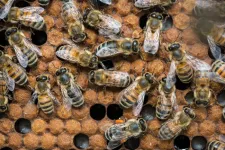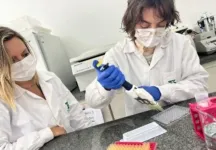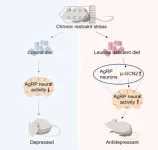(Press-News.org) Greenhouse gases act like a layer of window glass in the atmosphere: They prevent heat from being radiated from the Earth's surface into space. Methane does that 28 times as effectively as carbon dioxide - it is (to stay in the picture) a kind of invisible double glazing.
Over the past 200 years, the concentration of methane in the atmosphere has more than doubled. This is mainly due to human meat consumption: For one thing, cows and other ruminants produce methane during digestion. Another important source is the excrement of the animals. "One-third of the world's man-made methane comes from livestock," explains Felix Holtkamp, who is completing his doctorate at the INRES Institute of Crop Science and Resource Conservation at the University of Bonn. "It's estimated that up to 50 percent of it originates from fermentation processes in the slurry."
Researchers around the globe are therefore looking for ways to suppress these processes. Holtkamp, his scientific supervisor Dr. Manfred Trimborn from the Institute for Agricultural Engineering at the University of Bonn, and Dr. Joachim Clemens from the fertilizer manufacturer SF-Soepenberg GmbH have now presented a promising solution to the problem. "We combined slurry from a farm in the lab with calcium cyanamide, a chemical that has been used as a fertilizer in agriculture for more than 100 years," Holtkamp says. "This brought methane production to an almost complete halt."
Emissions fell by 99 percent
Overall, emissions fell by 99 percent. This effect started barely an hour after the addition and persisted until the end of the experiment half a year later. The long effectiveness is important, because slurry is not simply discarded. Rather, it is stored until the beginning of the following growing season and then spread on the fields as a valuable fertilizer. Months of storage are therefore quite common.
During this time, the slurry is transformed by bacteria and fungi: They break down undigested organic material into smaller and smaller molecules. Methane is produced at the end of these processes. "Calcium cyanamide breaks this chain of chemical transformations, and does so simultaneously at different points, as we were able to see in the chemical analysis of the slurry treated accordingly," Holtkamp explains. "The substance suppresses the microbial degradation of short-chain fatty acids, an intermediate in the chain, and their conversion to methane. Exactly how this happens is still unknown."
But the substance has other advantages as well: It enriches the slurry with nitrogen and thus improves its fertilizing effect. It also prevents the formation of so-called floating layers - these are deposits of organic matter that form a solid crust on the slurry and hinder gas exchange. This crust usually needs to be regularly broken up and stirred in.
The process also has advantages for the animals themselves: They are often kept on so-called slatted floors. Their excrement falls through openings in the floor into a large container. Microbial conversion allows the fecal-urine mixture to foam up over time and rise back up through the gaps. "The animals are then standing in their own excrement," Holtkamp says. "Calcium cyanamide stops this foaming." The costs are also manageable - they are around 0.3 to 0.5 cents per liter of milk for cattle farming.
Slurry "purity law" currently prevents use
It is still unclear how the method affects the release of ammonia from the slurry. Ammonia is a toxic gas that, while not harmful to the climate itself, can be converted to dangerous greenhouse gases. "We have initial indications that the amount of ammonia is also reduced in the long term," says Dr. Manfred Trimborn of the Institute of Agricultural Engineering at the University of Bonn. "We can't say for sure at this point, though."
In Germany, an environmental law currently prevents the addition of calcium cyanamide: A strict purity requirement applies to conventionally stored slurry at present.
Participating institutions:
In addition to the University of Bonn, SF-Soepenberg GmbH in Hünxe was involved in the study.
END
Additive to make slurry more climate-friendly
Study by the University of Bonn confirms reduction of the greenhouse gas methane by 99 percent
2023-03-03
ELSE PRESS RELEASES FROM THIS DATE:
Case study of rare, endangered tortoise highlights conservation priorities for present, future World Wildlife Days
2023-03-03
Though wildlife trafficking has been effectively disrupted since the first World Wildlife Day—established 50 years ago today via the 1973 Convention on International Trade in Endangered Species (CITES) of Wild Fauna and Flora—a newly published case study on one of the world’s rarest tortoise species, the ploughshare tortoise, highlights how much room for improvement still exists.
In a new paper published in the Proceedings of the National Academies of the Sciences, University of Maryland Associate Professor Meredith Gore and her coauthors—Babson College’s Emily Griffin, ...
Fluorescent protein sheds light on bee brains
2023-03-03
An international team of bee researchers involving Heinrich Heine University Düsseldorf (HHU) has integrated a calcium sensor into honey bees to enable the study of neural information processing including response to odours. This also provides insights into how social behaviour is located in the brain, as the researchers now report in the scientific journal PLOS Biology.
Insects are important so-called model organisms for research. Despite more than 600 million years of independent evolution, insects share more than 60% of their DNA with humans. For several decades it was mainly the fruit fly ...
Researchers identify gene mutation capable of regulating pain
2023-03-03
Pain afflicts at least 1.5 billion people worldwide, and despite the availability of various painkilling drugs, not all forms of pain are treatable. Moreover, pain medications can have side-effects such as dependence and tolerance, especially in the case of morphine and other opioids.
In search of novel painkillers, researchers at Butantan Institute’s Special Pain and Signaling Laboratory (LEDS) in São Paulo, Brazil, studied TRPV1, a sensory neuron receptor that captures noxious stimuli, including heat and the burning sensation conveyed by chili peppers, and ...
Chemotherapy-resistant ovarian cancer cells protect their neighbors
2023-03-03
Certain chemotherapy-resistant ovarian cancer cells protect neighboring cancer cells by sending signals that induce resistance, according to a new study from University of Pittsburgh and UPMC researchers that may help explain why ovarian cancer patients respond poorly to chemotherapy or relapse after treatment.
Published in Clinical Cancer Research, the study investigated chemotherapy-resistant cancer cells called quiescent cells. As chemotherapy primarily targets rapidly dividing cells, quiescent cells are resistant because they divide ...
When ‘good genes’ go bad: how sexual conflict can cause population collapse
2023-03-03
Males of a species evolving traits for sexual conflict can cause problems for females, and, ultimately, the whole population.
A new model by Imperial College London and University of Lausanne researchers, published in Proceedings of the National Academy of Sciences, shows how so-called ‘good genes’ can sometimes cause a population to collapse.
Males of any species may compete for females, either by fighting other males for access or impressing females to win their approval. In both cases, ...
UC Davis study uncovers age-related brain differences in autistic individuals
2023-03-03
A new study led by UC Davis MIND Institute researchers confirms that brain development in people with autism differs from those with typical neurodevelopment. According to the study published in PNAS, these differences are linked to genes involved in inflammation, immunity response and neural transmissions. They begin in childhood and evolve across the lifespan.
About one in 44 children in the U.S. has autism. Autistic individuals may behave, communicate and learn in ways that are different from neurotypical people. As they age, they often have challenges with social communication ...
An interdisciplinary solution for enhanced high-resolution imaging in electron and optical microscopy
2023-03-03
Although electron microscopy can already reveal details as small as one nanometer, ongoing research seeks to break through barriers limiting image quality and reducing the optical dose on the samples. Aberration is a common problem in electron microscopy that can reduce the resolution and quality of the images produced. Additional complex phase and amplitude controls are needed in these microscopes. An international team of researchers led by Akhil Kallepalli (Kallepalli Lab) working within the Optics Group at the University of Glasgow set out to address the problem. Working from an optics perspective, they developed and tested a new ghost ...
Tree rings and strontium point researchers to the provenance of 400-year-old timber
2023-03-03
Tree-ring analysis – so-called dendrochronological analysis – has been part of archaeology for many years and has made it possible for archaeologists to date old wooden objects with great precision. And in many cases, they have also been able to determine the provenance of the wood.
But it has proven difficult for researchers to determine timber’s place of origin when the historic timber was imported into Denmark from further afield to serve as building material.
In a new study in the journal PLOS ONE, Associate Professor Aoife Daly and Dr Alicia Van Ham-Meert from the University of Copenhagen show that combining analyses of ...
Chinese scientists discovered roles of hypothalamic amino acid sensing in antidepressant effects
2023-03-03
Depression is a leading cause of disability around the world and contributes greatly to the global burden of disease. Nutrition is essential for the maintenance of normal emotional states. Nutritional therapy is rising up in many disease treatments, but little is known in the depression field. Unbalanced nutrition is implicated in the etiology of depression, potentially hindering treatment. For example, many essential amino acids (EAAs) in serum are changed in patients with depression, such as tryptophan, threonine, leucine, isoleucine, and valine. However, whether EAA contributes to depression ...
Health policy experts call for confronting anti-vaccine activism with life-saving counter narratives
2023-03-03
Public and private sector health officials and public policymakers should team up immediately with community leaders to more effectively disseminate accurate narratives regarding the life-saving benefits of vaccines to counter widespread, harmful misinformation from anti-vaccine activists.
Such is the message of a UC Riverside-led viewpoint piece published Thursday, March 2, in the leading international medical journal, The Lancet.
“We need to consistently amplify the best science and find the best ways of communicating so that people are hearing it through multiple channels instead of through one or two sources,” ...
LAST 30 PRESS RELEASES:
SwRI upgrades nuclear magnetic resonance laboratory for pharmaceutical R&D
House sparrows in northern Norway can help us save other endangered animals
Crohn's & Colitis Foundation survey reveals more than 1/3 of young adults with IBD face step therapy insurance barriers
Tethered UAV autonomous knotting on environmental structures for transport
Decentralized social media platforms unlock authentic consumer feedback
American Pediatric Society announces Vanderbilt University School of Medicine as host institution for APS Howland Visiting Professor Program
Scientists discover first method to safely back up quantum information
A role for orange pigments in birds and human redheads
Pathways to net-zero greenhouse gas emissions for Southeast Asia
A JBNU–KIMS collaborative study on a cost-effective alloy matches superalloys for power plants and energy infrastructure
New study overturns long-held model of how plants coordinate immune responses.
New AI model predicts disease risk while you sleep
Scientists discover molecular ‘reshuffle’ and crack an 80-year-old conundrum
How stressors during pregnancy impact the developing fetal brain
Electrons lag behind the nucleus
From fungi to brain cells: one scientist's winding path reveals how epigenomics shapes neural destiny
Schizophrenia and osteoporosis share 195 genetic loci, highlighting unexpected biological bridges between brain and bone
Schizophrenia-linked genetic variant renders key brain receptor completely unresponsive to both natural and therapeutic compounds
Innovative review reveals overlooked complexity in cellular energy sensor's dual roles in Alzheimer's disease
Autism research reframed: Why heterogeneity is the data, not the noise
Brazil's genetic treasure trove: supercentenarians reveal secrets of extreme human longevity
The (metabolic) cost of life
CFRI special issue call for papers: New Frontiers in Sustainable Finance
HKU Engineering scholar demonstrates the smallest all-printed infrared photodetectors to date
Precision empowerment for brain "eavesdropping": CAS team develops triple-electrode integrated functional electrode for simultaneous monitoring of neural signals and chemical transmitters during sleep
Single-capillary endothelial dysfunction resolved by optoacoustic mesoscopy
HKU three research projects named among ‘Top 10 Innovation & Technology News in Hong Kong 2025’ showcasing excellence in research and technology transfer
NLRSeek: A reannotation-based pipeline for mining missing NLR genes in sequenced genomes
A strand and whole genome duplication–aware collinear gene identification tool
Light storage in light cages: A revolutionary approach to on-chip quantum memories
[Press-News.org] Additive to make slurry more climate-friendlyStudy by the University of Bonn confirms reduction of the greenhouse gas methane by 99 percent










